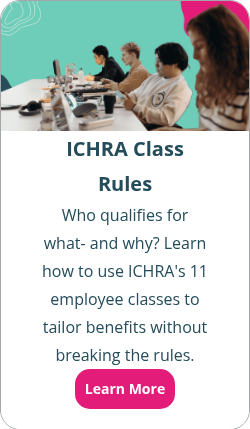ICHRA rules you need to know
By Holly Bengfort on June 13, 2024 at 7:30 AM
With the rising cost of traditional group health plans, many employers are looking for alternatives that meet their employees' diverse needs. Thankfully, health reimbursement arrangements (HRAs) are an option. These formal, IRS-approved health benefits allow organizations to reimburse their employees for the qualifying medical expenses of their choosing while offering budget control.
An individual coverage HRA (ICHRA) is a popular type of health reimbursement that works for organizations of all sizes. With an ICHRA, employers reimburse employees for the cost of their own individual qualified health plans instead of buying a group plan for them.
If your organization plans to offer an ICHRA, there are some crucial points to consider. When the federal government created the ICHRA, it provided specific regulatory guidelines to ensure employers administer the plan compliantly. These guidelines dictate a range of factors, from employee eligibility to plan documents and employee notices.
In this article, we'll explain what an ICHRA is and the important ICHRA rules organizations should know.
Takeaways from this blog post:
- Businesses offering an individual coverage HRA (ICHRA) should provide a 90-day notice period before each plan year, outlining the terms of the ICHRA, opt-out options, impact on APTC eligibility, and other important information.
- To be eligible for an ICHRA, employees need to be covered by a qualifying individual plan.
- Organizations can structure ICHRA eligibility by employee classes, such as full-time employees or part-time employees. Allowances must be the same within each class of employees.
What is an individual coverage HRA (ICHRA)?
An ICHRA allows organizations of all sizes to provide tax-free reimbursements to employees for individual health insurance premiums and qualifying out-of-pocket medical expenses.
Some examples of eligible expenses include:
- Doctor visits
- Prescription drugs
- Over-the-counter medication
- Mental health counseling
The ICHRA gives your workers more freedom over their health benefits and lets them choose how they want to use their healthcare allowance, which isn't possible when you offer a traditional group health plan to employees.
An ICHRA is especially helpful for small to mid-sized businesses and nonprofit organizations that can't afford to provide a group health insurance policy or need more flexibility in their benefits.
The federal government created the individual coverage HRA in 2019 to expand HRA availability to applicable large employers (ALEs) with 50 or more full-time equivalent employees (FTEs) and to help control healthcare costs for businesses of all sizes.
An ICHRA isn't the only type of HRA available, though.
Other popular types of HRAs include:
- The qualified small employer HRA (QSEHRA): The QSEHRA is for small employers with fewer than 50 FTEs. Like the ICHRA, a QSEHRA allows you to reimburse employees for out-of-pocket healthcare costs and insurance premiums.
- The group coverage HRA (GCHRA): The GCRHA, also known as an integrated HRA, works alongside a traditional group health plan. It helps pay for out-of-pocket expenses the group plan doesn’t fully cover. However, monthly health insurance premiums aren't reimbursable with a GCHRA.
- The excepted benefit HRA (EBHRA): Like the GCHRA, the EBHRA supplements an existing traditional group health plan. An EBHRA allows employers to reimburse employees for premiums paid for certain excepted benefits and other eligible out-of-pocket medical care expenses.
Now that we’ve explored what an ICHRA is, let’s look at some of the ICHRA rules you need to know.
The ICHRA notice requirement
According to federal regulations1, businesses offering an ICHRA must generally provide a 90-day notice period before each plan year. However, there are some circumstances where this recommended notice isn't possible.
The ICHRA final rules recommend that HRA administrators send a notice to employees about the newly available employee benefit and their eligibility to participate at least 90 days before the ICHRA's start date.
The notice requirement differs for newly-eligible employees (like employees who gain eligibility after the beginning of the plan year or newly hired employees). Newly established organizations also have some leniency with the recommended notice.
A business can provide the notice at any time until the first day the employee's ICHRA coverage begins. It's a good practice to provide notice as soon as possible to ensure the employee has time to review their coverage options and select a medical plan.
Organizations should provide the ICHRA notice every year the business chooses to offer the ICHRA.
Here's what an ICHRA notice must include:
- A description of the terms of the ICHRA
- A statement of the right of the participant to opt out of and waive future reimbursement under the HRA
- A statement on how the ICHRA will affect advance premium tax credit (APTC) eligibility, whether the employee opts out or chooses to accept the benefit
- A statement that the participant must inform any exchange to which they apply for APTC of relevant information
- A statement about how the ICHRA differs from other HRAs
- A statement about the availability of a special enrollment period (SEP) for employees and dependents who gain access to the HRA
- A statement about how the participant can find assistance for determining their individual coverage HRA affordability
- A statement that the ICHRA can be integrated with Medicare. Employees must be informed that they can integrate Medicare with the ICHRA
- Contact information of an individual or a group of individuals for the participants to contact with questions regarding their ICHRA
How to set up ICHRA plan documents
The federal government considers an ICHRA a group employee health benefit. It’s, therefore, subject to the Employee Retirement Income Security Act (ERISA).
Under Section 402 of ERISA2, the regulations state that every employee benefit plan must be “established and maintained pursuant to a written instrument.” This means employee benefit plans must include a formal document defining the plan. ERISA also requires that the employer make the plan document available to employees and their families.
Along with the formal plan document, an employee health plan must also include a summary plan document (SPD). This is to provide a summary of the complete plan document to eligible employees. While the formal plan document is generally written in complex legal language, you should write the SPD in a way that's easy for the average plan participant to understand.
While there aren't any defined penalties for failing to meet these requirements, organizations are subject to Internal Revenue Service (IRS) fines if participants in an ICHRA ask to see the plan document and the employer doesn't provide one.
Additionally, organizations can be at risk for potential fines if an SPD is not made available to eligible employees within 120 days of the ICHRA's creation. For employees newly enrolled in an existing ICHRA, the organization has only 90 days to deliver the SPD.
ERISA requires certain items to be included in the employee health plan documents. In addition, businesses should include several items specific to the ICHRA as a best practice.
Here is a list of items a business should include in its ICHRA plan documents:
- Named fiduciaries and plan administrators and their responsibilities
- Eligibility requirements for the ICHRA
- Effective dates of participation
- Description of benefits, both those provided and those excluded
- How the ICHRA is funded and how it makes payments
- Claims procedures
- HIPAA privacy officers and rules regarding protected health information (PHI)
- Information on federal mandates
- The procedure for amending the plan
- The procedure for plan termination
ICHRA eligibility for employees
Another critical aspect of the ICHRA is how employee eligibility is defined. According to ICHRA regulations, all participants need a qualifying individual health insurance plan to participate in the benefit.
Employees covered by a traditional group health plan, including a spouse's or parent's plan, can't participate in an ICHRA. This includes COBRA, healthcare sharing ministries, association health plans, and Tricare.
Uninsured employees also can't participate in an ICHRA, meaning they'll need individual health insurance coverage to be eligible.
Only W-2 employees can participate in an ICHRA. So, partners and sole proprietors that don’t elect for the IRS to tax them as a C corporation can’t participate. Additionally, S corporation owners, their spouses, and 2% shareholders can't participate in an ICHRA. However, employees of these organizations would still be eligible.
If you're under a spouse's or parent's insurance plan, that doesn't mean you can't purchase individual health insurance coverage. If you purchase your own individual insurance on the individual market, you can opt-in to the benefit and become "double-covered." Typically, your individual health policy will become your primary plan.
How employee classes affect ICHRA eligibility
An ICHRA gives employers flexibility in determining who is eligible for the benefit. Instead of offering the benefit to all employees, an organization may structure ICHRA eligibility according to employee classes.
There are many types of employee classes under an ICHRA, including:
- Full-time employees
- Part-time employees
- Hourly employees
- Salaried employees
- Seasonal employees
- Employees in a waiting period
- Temporary employees who work through a temp agency
- Employees covered under a collective bargaining agreement
- Employees in different locations, based on states or rating areas
- Foreign employees who are working abroad
- Any combination of the options above
Keep in mind that if you're offering an ICHRA through an ICHRA administration software provider, like PeopleKeep, the software may not support all of the above class options.
An organization can limit eligibility to employees who fall into one or more of the 11 categories. Alternatively, an employer can choose to offer the benefit to all employees without using classes. If the organization allows it, the spouses and dependents of eligible employees can also participate in the ICHRA.
If you offer a traditional group health plan, you can't offer it to the same classes of employees that are offered the ICHRA. In other words, you can't offer an employee both the group plan and the ICHRA. You must offer the two plans exclusively to remain compliant.
If you choose to use classes for your ICHRA benefit and offer a group health plan to other classes, there are minimum class size requirements.
The rules on minimum ICHRA class sizes state:
- If you have fewer than 100 employees, you must have at least 10 employees in the class
- If you have between 100 and 200 employees, you must have at least 10% of your employees in a class
- If you have more than 200 employees, you need at least 20 employees in a class
What is individual health insurance coverage?
As discussed above, eligible employees must have a qualifying individual coverage health insurance plan to participate in the ICHRA. That said, what qualifies as individual coverage?
Individual coverage is an individual health insurance policy, including on-exchange or off-exchange coverage, Medicare Parts A and B, or Medicare Part C. The plan must meet minimum essential coverage (MEC) standards and include the 10 essential health benefits. On-exchange plans already meet these requirements. An employee can be the primary policyholder, or they can have coverage under a family member's individual policy.
Policies that aren't considered individual coverage include the following:
- Traditional group health plan
- Tricare
- COBRA
- Short-term medical insurance
- Ministry sharing plans
How to substantiate individual health insurance coverage and meet attestation requirements
Another essential rule to note is that employers offering an ICHRA must take reasonable steps to ensure that eligible employees and their participating dependents are enrolled in individual health coverage.
Your current employees need to meet attestation and substantiation requirements at the start of each plan year and each time they submit a reimbursement request. Newly hired employees need also need to meet these requirements when they become newly eligible for the benefit.
According to ICHRA regulations, the plan administrator or employer can substantiate individual coverage.
Substantiation option 1: Provide proof of coverage
Employees can directly provide their employer with proof of coverage from an insurance card, explanation of benefits (EOB), or other document stating the employee (and any dependents) will have individual health coverage for the plan year or relevant month. This proof of coverage should come from a third party, like an exchange or the insurance provider.
Substantiation option 2: Employee attestation of coverage
Employees can provide written or electronic attestation of coverage to the employer. This attestation states that the employee and their dependents will have individual health coverage for the plan year (or relevant month). The attestation must include the date the insurance coverage begins as well as the name of the coverage provider.
The final rules regarding the ICHRA state that employers or plan administrators can assume the attestation or documentation the employee provides is valid for substantiation of individual coverage as long as the plan administrator or employer has no knowledge that it’s misleading or inaccurate. Because of this, employers aren’t burdened with having to verify individual coverage for their participating employees directly.
If you use PeopleKeep to administer your ICHRA, our software facilitates the substantiation and attestation process for you.
ALEs must provide affordable benefits
The ACA mandates that employers with 50 or more full-time equivalent employees (FTEs) provide health coverage to their employees. An ICHRA satisfies the employer mandate provided you offer an affordable allowance and every opted-in employee has individual plans that meet minimum essential coverage (MEC).
The affordability requirement encourages ALEs to offer a meaningful benefit to their employees. Otherwise, employers could decide to offer a $5 per month health benefit just to satisfy the law.
An ICHRA is considered affordable if the amount an employee has to pay out-of-pocket for a self-only, lowest-cost silver plan is less than 9.96% of the employee's household income in 2026.
This means that their monthly premium minus their ICHRA allowance can't exceed the 9.96% value for the month.
To determine annual household income, the IRS has established safe harbor methods for calculating affordability:
- W-2 wages for your employees
- Use rate of pay, or your employee's hourly rate multiplied by 130 to get a monthly total
- Federal Poverty Line (FPL)
Other factors can affect affordability, and the IRS has established other safe harbors outlined in IRS Notice 2018-883.
These additional safe harbors include:
- Location: Employers can use the primary site of employment to determine affordability
- Calendar year: Employers who offer an ICHRA the following calendar year can use the current year's estimates as a baseline
- Age: Employers can use the age of the employee on the first day of the plan year
If your ICHRA isn't affordable, the employee can opt out of the benefit and receive a premium tax credit instead (assuming they are eligible for a tax credit). However, if your ICHRA is considered affordable, your employees can't opt out and receive tax credits. Additionally, employees who opt-in to the ICHRA can't continue to collect premium tax credits.
Why offer an ICHRA?
Why might you offer an ICHRA instead of a traditional group health plan with all of these special rules?
Unlike other benefits, an ICHRA has no maximum amounts or minimums, meaning you have complete cost control as an employer. You can set the monthly allowance amounts that work best for your organization. As long as it's affordable for your employees based on their household income, you can also satisfy the ACA's employer mandate.
An ICHRA also allows your employees to get reimbursed for the qualifying medical expenses that matter most to them. Instead of forcing your workers into a one-size-fits-all group health insurance plan, your employees can choose the individual health plan that works best for their needs and use any leftover ICHRA allowance on eligible out-of-pocket costs of their choice. This gives your employees more control over their benefits.
Conclusion
While the individual coverage health reimbursement arrangement (ICHRA) is a fantastic healthcare benefit that can help organizations stay on budget, it's vital for employers offering it to maintain compliance. This ensures your organization and your employees can enjoy the perks of the benefit without having to worry about penalties or fines.
If you're interested in offering an ICHRA to your employees, PeopleKeep can help! Our HRA administration software makes it easy for organizations like yours to set up and manage their benefits in minutes each month.
This blog article was originally published on December 27, 2019. It was last updated on June 13, 2024.
Check out more resources
See these related articles

HRAs and S corporation owners
While S-corporation owners can't participate in HRAs, they can still be a good option to offer to employees instead of traditional group insurance.

What to expect when your employer offers you an ICHRA
Curious about ICHRAs? Discover what to expect when your employer offers you an individual coverage health reimbursement arrangement with this guide.

How does the QSEHRA work with Medicare?
Learn how the QSEHRA can assist with your Medicare supplemental premiums and maximize your healthcare benefits in this informative article.



